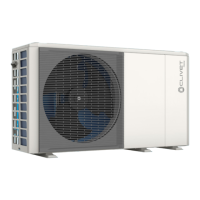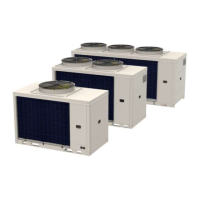12
About R-290 refrigerant
parts of the system
• place the cylinder on the scale
• start the recovery device and use it according to the
manufacturer's instructions
• do not fill the cylinders excessively. (Do not exceed 80% of
the liquid volume)
• do not exceed the maximum working pressure of the
cylinder, even temporarily
• after filling the cylinders correctly and completing the
procedure, transfer the cylinders and equipment from
the site as soon as possible and close all shut-off valves
on the equipment.
• before charging the recovered refrigerant into another
refrigeration system, it must be cleaned and checked.
3.3.17 Labelling
Remember that:
• the device must be labelled to indicate that it has been
decommissioned and emptied of refrigerant
• the label must be dated and signed
• check that labels indicating the content of flammable
refrigerant are affixed to the device.
3.3.18 Recovery
When discharging refrigerant from a system for maintenan-
ce or decommissioning reasons.
Check that:
• the refrigerant is removed safely
• only cylinders suitable for refrigerant recovery are used
• the number of cylinders required to hold the entire
system charge is available
• all cylinders to be used are designed for the refrigerant
recovered and labelled for that refrigerant (special refri-
gerant recovery cylinders)
• the cylinders are equipped with a pressure relief valve
and well-functioning shut-off valves
• empty recovery cylinders are evacuated and, if possible,
cooled before recovery
• the recovery equipment is in good working order, accom-
panied by a set of instructions at hand, and suitable for
the recovery of flammable refrigerants
• a set of well-functioning calibrated scales is provided
• the pipes are complete with decoupling fittings that are
leak-free and in good condition
• the recovery equipment is in good working order, has
been properly maintained and the associated electrical
components are sealed to prevent a risk of ignition in
the event of refrigerant leakage. If in doubt, consult the
manufacturer.
• the refrigerant is returned to the supplier in the correct
recovery cylinders, accompanied by the relevant waste
identification form
• different types of refrigerant are not mixed in the reco-
very units, especially in the cylinders
• if compressors or compressor oils are decommissioned,
evacuate them to an acceptable level to prevent flam-
mable refrigerant from remaining inside the lubricant
• the evacuation procedure is carried out before returning
the compressor to the suppliers
• only the electric heating on the compressor body is used
to accelerate this process
• when oil is extracted from the system, it is drained using
a safe procedure.
3.3.19 Transportation, marking, storage and
disposal of units
• comply with current national regulations.
3.3.20 Receipt and handling
On receipt of the unit:
• check if there is refrigerant inside the packaging using an
electronic leak detector suitable for the system refrige-
rant
• if there is, it is likely that the refrigerant circuit is dama-
ged
• In this case, the unit must not be installed and the Techni-
cal Support Service must be called.
3.4 Safety area
Remember that:
• the unit contains highly flammable refrigerant
• there is a risk of fire and explosion
• the refrigerant must be prevented from entering the
building
• the refrigerant can form a combustible atmosphere by
mixing with the air
• the refrigerant has a higher density than air, in the event
of a leak, spilled refrigerant can accumulate on the
ground and in vents
• the safety area must not include neighbouring properties
or busy public areas
• no structural changes may be made in the safety area
that would breach these regulations.
Preparation of the safety area
The unit must not be near:
• windows, doors, shafts, basement entrances, hatches,
skylights
• outside air inlets of ventilation systems
• canals, downpipes, manholes, pumping wells, sewerage
ducting networks, etc.
The safety area must not contain ignition sources:
• sockets, light wells, lamps or power switches
• naked flames or flame bodies
• electrical appliances that are not explosion-proof, mobile

